Chidambaram
Historical background
The Nataraja temple at Chidambaram is the first and foremost among the 275 Shaivasthalams, or Shaiva holy places. The deity is worshipped here as Nataraja, Lord of the Dance, an aspect whose mythology, theology and iconography are intimately connected with the Tamil region. In the tenth century Nataraja became the patron deity of the Chola dynasty (850-1290 CE), and since then Chidambaram has remained the focus of Shaiva worship and one of the major pilgrimage destinations in Tamil Nadu.
Read more
The temple, whose core dates probably from the Chola period, was subsequently enlarged by the Vijayanagara, Nayaka and Maratha dynasties, and more recently, in the 19th and early 20th century the Chettiars – a wealthy merchant community – were responsible for some major refurbishments. At the core of the temple are the Kanaka Sabha (Golden Hall) and the Chit Sabha (Hall of Consciousness) both of which appear in the paintings along with the more modest mulasthana, the seat of the ‘original’ linga.
Sited on the western side of the Shivaganga tank is the Shivakamasundari or Shivakami shrine which houses Parvati. Parts of it are assigned to the late Chola period, the mandapa, or open pillared hall and its ceiling paintings belong to the 17th century Nayaka period.
The mandapa measures c 26 x 18 m and is divided into five bays by six rows of pillars. The central bay is the largest and is adorned by paintings of the late 20th century, replacing the old ones. Accommodated in the four remaining bays are three sets of paintings. The first is the story of the temple according to the 13th (?) century Chidambara Mahatmya and its Tamil version, the Koyil Puranam dating of the first half of the 14th century. This complex narrative is laid out in the two northernmost bays. The second story, laid out in the second bay from the south is drawn from the Chidambaram Puranam by the poet Tirumalainatan (1508). The paintings focus on the merits one acquires by having seen the image of Nataraja enshrined in the Chit Sabha, and celebrate the worship of Shiva. Of particular interest are the depictions of a number of Shaiva shrines in the region. The southernmost bay of the hall is devoted to the rendering of the life of Manikkavachakar, one of the great Shaiva poets and mystics who lived in the 9th century. After an eventful life he settled in Chidambaram where he is said to have merged into Shiva. A possible textual source for this set of paintings may be Katavunmamunivar’s 15th (?) century Tiruvatavurar Puranam, in which the life of Manikkavachakar is narrated in great detail.
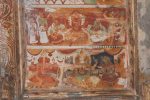
Date: 17th century
Description: Bottom row: Shiva on Mount Kailasa flanked by Parvati and Narada (right) and Ganesha. Top row: Vishnu in Vaikuntha flanked by Sridevi, Bhudevi and attendants.
Location: Tamil Nadu Temple;Nataraja Temple complex;Chidambaram
Positioning: Shivakamasundari shrine; open mandapa, northernmost bay (E)
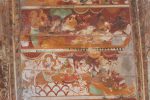
Date: 17th century
Description: Bottom row Shiva on Mount Kailasa flanked by Parvati, Narada (left) Adhikaranandi (right); Shiva recites the Koyil Puranam (story of the Chidambaram temple) to Adhikaranandi, who repeats it to Sanatkumara; Top row: Sanatkumara recites it to Vedavyasa, and Vedavyasa to Suta.
Location: Tamil Nadu Temple;Nataraja Temple complex;Chidambaram
Positioning: Shivakamasundari shrine; open mandapa, northernmost bay (E)
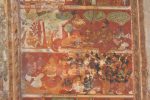
Date: 17th century
Description: Bottom row: The sages of the Naimisha forest listen to the Koyil Puranam; Top row: sage Madhyandina teaches the Vedas to his son, Vyaghrapada. The youth wants to know which is the best kind of tapas (penance).
Location: Tamil Nadu Temple;Nataraja Temple complex;Chidambaram
Positioning: Shivakamasundari shrine; open mandapa, northernmost bay (E)
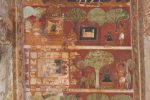
Date: 17th century
Description: Bottom row: Madhyandina and his son, Vyaghrapada, worship the Mulasthanam (the original linga shrine in the Chidambaram Temple complex); On the left is the temple tank and smaller shrines along it; Top row: The young sage wanders in the Tillai forest and worships a linga; He bathes in the tank; He builds a temple in which he worships a linga. The last vignette on the left shows Vyaghrapada in front of a heap of flowers with bees on top.
Location: Tamil Nadu Temple;Nataraja Temple complex;Chidambaram
Positioning: Shivakamasundari shrine; open mandapa, northernmost bay (E)
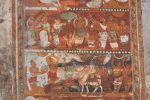
Date: 17th century
Description: Bottom row: Vyaghrapada obtains from Shiva the boon that his hands and feet are transformed into tiger paws with eyes: this will enable him to gather the flowers for the puja before the bees contaminate them. Top row: The wedding of Vyaghrapada.
Location: Tamil Nadu Temple;Nataraja Temple complex;Chidambaram
Positioning: Shivakamasundari shrine; open mandapa, northernmost bay (E)
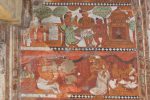
Date: 17th century
Description: Bottom row: Vyaghrapada has a son, Upamanyu, who had the privilege of tasting the milk of the divine cow, Surabhi. He finds the home food tasteless and refuses to eat it. Top row: Upamanyu and his parents near a tank. His father places him in front of the Shiva temple where he receives the Milky Ocean.
Location: Tamil Nadu Temple;Nataraja Temple complex;Chidambaram
Positioning: Shivakamasundari shrine; open mandapa, northernmost bay (E)
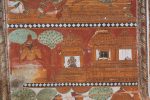
Date: 17th century
Description: Vyaghrapada in meditation before the empty Chit Sabha (Hall of Consciousness) waiting for Nataraja to appear in Chidambaram. To the left of the empty hall is the Mulasthanam (the original linga shrine in the Chidambaram temple complex).
Location: Tamil Nadu Temple;Nataraja Temple complex;Chidambaram
Positioning: Shivakamasundari shrine; open mandapa, northernmost bay (E)
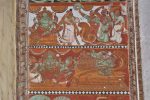
Date: 17th century
Description: Bottom row: Vishnu reclining on the serpent Shesha, wakes up thinking of the dance of Shiva. He then sits on his throne, flanked by his consorts Sridevi and Bhudevi. Top row: Shesha approaches Vishnu enthroned and Lakshmi standing near him. On the right, a fan bearer and two fly whisk bearers.
Location: Tamil Nadu Temple;Nataraja Temple complex;Chidambaram
Positioning: Shivakamasundari shrine; open mandapa, northernmost bay (E)
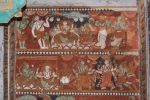
Date: 17th century
Description: Top row; Shiva and Parvati on Mount Kailasa receive Vishnu (right); on the extreme left, Narada and Tumburu; Bottom row: Shiva and Vishnu accompanied by their retinue walk towards a pavilion where they have a conversation.
Location: Tamil Nadu Temple;Nataraja Temple complex;Chidambaram
Positioning: Shivakamasundari shrine; open mandapa, second bay from the north (E)
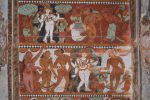
Date: 17th century
Description: Top row: Shiva as Bhikshatana and Vishnu as Mohini accompanied by their retinue, prepare to go to the Daruka forest; Bottom row: Shiva seduces the wives of the rishis, whose garments slip from their bodies. To the extreme right, fully dressed, is Arundhati.
Location: Tamil Nadu Temple;Nataraja Temple complex;Chidambaram
Positioning: Shivakamasundari shrine; open mandapa,second bay from the north (E)
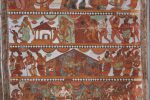
Date: 17th century
Description: Top row; Arundhati alone near the yajnashala (sacrificial hall); The rishis infatuated by Mohini rush towards her; Bottom row: The incensed rishis sit on either side of the yajnashala; One of them inside the hall, tends the sacred flame from which emerge all kinds of fearful creatures: a tiger, a snake, the dwarfish Apasmara, and a bee (symbolising the mantras).
Location: Tamil Nadu Temple;Nataraja Temple complex;Chidambaram
Positioning: Shivakamasundari shrine; open mandapa, second bay from the north (E)
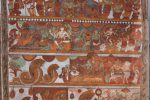
Date: 17th century
Description: Top row: The creatures generated by the rishis yajna attack Shiva: On the right Shiva dances the ananda tandava (dance of bliss) before Vishnu and some devotees; Bottom row: Shesha and his son before Vishnu who has just finished his account of the Daruka forest incident. Vishnu encourages Shesha to worship Shiva until he will be given the boon to see the ananda tandava. On the right, Shiva mounted on Nandi returns to Mount Kailasa.
Location: Tamil Nadu Temple;Nataraja Temple complex;Chidambaram
Positioning: Shivakamasundari shrine; open mandapa, second bay from the north (E)
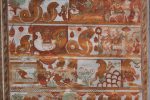
Date: 17th century
Description: Top row: Shesha performs panchagnitapas (five fire penance) and Shiva in the guise of Brahma appears before him to test his sincerity; Shiva then manifests himself in his true form and tells Shesha that the dance has to be performed at a proper place. He instructs Shesha to take the form of Patanjali and to go to the Nagaloka (snake world), where, on top of a mountain he will find Vyaghrapada performing puja before the Mulasthanam, with his mind fixed on the dance.
Location: Tamil Nadu Temple;Nataraja Temple complex;Chidambaram
Positioning: Shivakamasundari shrine; open mandapa, second bay from the north (E)
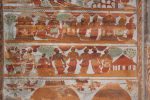
Date: 17th century
Description: Top row: Shesha in the form of Patanjali arrives at Chidambaram; He joins Vyaghrapada in worshipping the Mulasthanam, Anantishvara and Pulishvara; Bottom row: The sages join the worship of Shiva.
Location: Tamil Nadu Temple;Nataraja Temple complex;Chidambaram
Positioning: Shivakamasundari shrine; open mandapa, second bay from the north (E)
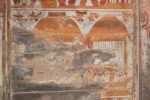
Date: 17th century
Description: The Chit Sabha (Hall of Consiousness) and the Kanaka Sabha (Golden Hall); Shiva has arrived to perform the ananda tandava (dance of bliss); The devotees have gathered to watch the dance.
Location: Tamil Nadu Temple;Nataraja temple complex;Chidambaram
Positioning: Shivakamasundari shrine; open mandapa, second bay from the north (E)
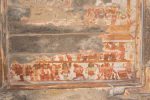
Date: 17th century
Description: Friezes of ganas (Shiva’s attendants) and musicians.
Location: Tamil Nadu Temple;Nataraja Temple complex;Chidambaram
Positioning: Shivakamasundari shrine; open mandapa, second bay from the north (E)
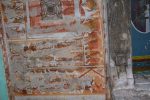
Date: 17th century
Description: Brahma is about to perform a yajna. The gods are in Chidambaram but refuse to attend. Vyaghrapada suggests that the priests should attend in their stead.
Location: Tamil Nadu Temple;Nataraja Temple complex;Chidambaram
Positioning: Shivakamasundari shrine; open mandapa, second bay from the north (W)
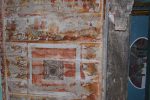
Date: 17th century
Description: Panel on the left: Sivakamasundari and attendants; Panel on the right: Brahma sits before the sacrificial fire, the dikpalas face him. Top row (from right to left) king Lokeshavikrama has a son, Simhavarman; He is a leper and feeling unfit to succeed his father decides to devote himself to asceticism, hoping to find a cure.
Location: Tamil Nadu Temple;Nataraja Temple complex;Chidambaram
Positioning: Shivakamasundari shrine; open mandapa, second bay from the north (W)
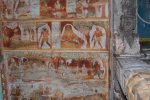
Date: 17th century
Description: Bottom row: (from right to left) King Lokeshavikrama has a son, Simhavarman who is a leper; Feeling unfit to succeed his father on the throne, he decides to devote himself to asceticism, hoping to find a cure. Second row: The youth wanders through many countries worshipping the linga. Third row: A Kirata (hunter) guides him to the Tillai forest where he worships the linga; Vyaghrapada sits on a hillock steeped in meditation.
Location: Tamil Nadu Temple;Nataraja Temple complex;Chidambaram
Positioning: Shivakamasundari shrine; open mandapa, second bay from the north (W)
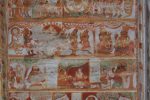
Date: 17th century
Description: Bottom row: The Kirata (hunter) accompanies the youth to meet Vyaghrapada; The youth pays homage to the sage who takes him to Chidambaram; Top row (right): Patanjali and Vyaghrapada; (left) The dance of Shiva is witnessed by Patanjali, Vyaghrapada, Simhavarman and a further figure.
Location: Tamil Nadu Temple;Nataraja Temple complex;Chidambaram
Positioning: Shivakamasundari shrine; open mandapa, second bay from the north (W)
1 2 3 … 5 Next »